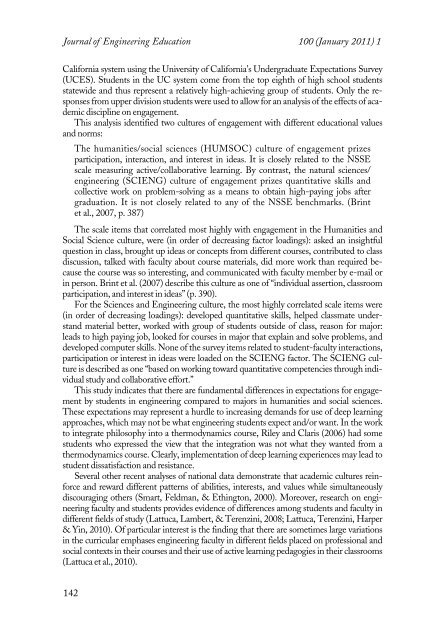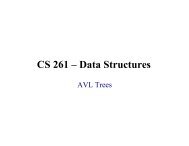Engineering Education and the Development of Expertise - Classes
Engineering Education and the Development of Expertise - Classes
Engineering Education and the Development of Expertise - Classes
You also want an ePaper? Increase the reach of your titles
YUMPU automatically turns print PDFs into web optimized ePapers that Google loves.
Journal <strong>of</strong> <strong>Engineering</strong> <strong>Education</strong> 100 (January 2011) 1<br />
California system using <strong>the</strong> University <strong>of</strong> California’s Undergraduate Expectations Survey<br />
(UCES). Students in <strong>the</strong> UC system come from <strong>the</strong> top eighth <strong>of</strong> high school students<br />
statewide <strong>and</strong> thus represent a relatively high-achieving group <strong>of</strong> students. Only <strong>the</strong> responses<br />
from upper division students were used to allow for an analysis <strong>of</strong> <strong>the</strong> effects <strong>of</strong> academic<br />
discipline on engagement.<br />
This analysis identified two cultures <strong>of</strong> engagement with different educational values<br />
<strong>and</strong> norms:<br />
The humanities/social sciences (HUMSOC) culture <strong>of</strong> engagement prizes<br />
participation, interaction, <strong>and</strong> interest in ideas. It is closely related to <strong>the</strong> NSSE<br />
scale measuring active/collaborative learning. By contrast, <strong>the</strong> natural sciences/<br />
engineering (SCIENG) culture <strong>of</strong> engagement prizes quantitative skills <strong>and</strong><br />
collective work on problem-solving as a means to obtain high-paying jobs after<br />
graduation. It is not closely related to any <strong>of</strong> <strong>the</strong> NSSE benchmarks. (Brint<br />
et al., 2007, p. 387)<br />
The scale items that correlated most highly with engagement in <strong>the</strong> Humanities <strong>and</strong><br />
Social Science culture, were (in order <strong>of</strong> decreasing factor loadings): asked an insightful<br />
question in class, brought up ideas or concepts from different courses, contributed to class<br />
discussion, talked with faculty about course materials, did more work than required because<br />
<strong>the</strong> course was so interesting, <strong>and</strong> communicated with faculty member by e-mail or<br />
in person. Brint et al. (2007) describe this culture as one <strong>of</strong> “individual assertion, classroom<br />
participation, <strong>and</strong> interest in ideas” (p. 390).<br />
For <strong>the</strong> Sciences <strong>and</strong> <strong>Engineering</strong> culture, <strong>the</strong> most highly correlated scale items were<br />
(in order <strong>of</strong> decreasing loadings): developed quantitative skills, helped classmate underst<strong>and</strong><br />
material better, worked with group <strong>of</strong> students outside <strong>of</strong> class, reason for major:<br />
leads to high paying job, looked for courses in major that explain <strong>and</strong> solve problems, <strong>and</strong><br />
developed computer skills. None <strong>of</strong> <strong>the</strong> survey items related to student-faculty interactions,<br />
participation or interest in ideas were loaded on <strong>the</strong> SCIENG factor. The SCIENG culture<br />
is described as one “based on working toward quantitative competencies through individual<br />
study <strong>and</strong> collaborative effort.”<br />
This study indicates that <strong>the</strong>re are fundamental differences in expectations for engagement<br />
by students in engineering compared to majors in humanities <strong>and</strong> social sciences.<br />
These expectations may represent a hurdle to increasing dem<strong>and</strong>s for use <strong>of</strong> deep learning<br />
approaches, which may not be what engineering students expect <strong>and</strong>/or want. In <strong>the</strong> work<br />
to integrate philosophy into a <strong>the</strong>rmodynamics course, Riley <strong>and</strong> Claris (2006) had some<br />
students who expressed <strong>the</strong> view that <strong>the</strong> integration was not what <strong>the</strong>y wanted from a<br />
<strong>the</strong>rmodynamics course. Clearly, implementation <strong>of</strong> deep learning experiences may lead to<br />
student dissatisfaction <strong>and</strong> resistance.<br />
Several o<strong>the</strong>r recent analyses <strong>of</strong> national data demonstrate that academic cultures reinforce<br />
<strong>and</strong> reward different patterns <strong>of</strong> abilities, interests, <strong>and</strong> values while simultaneously<br />
discouraging o<strong>the</strong>rs (Smart, Feldman, & Ethington, 2000). Moreover, research on engineering<br />
faculty <strong>and</strong> students provides evidence <strong>of</strong> differences among students <strong>and</strong> faculty in<br />
different fields <strong>of</strong> study (Lattuca, Lambert, & Terenzini, 2008; Lattuca, Terenzini, Harper<br />
& Yin, 2010). Of particular interest is <strong>the</strong> finding that <strong>the</strong>re are sometimes large variations<br />
in <strong>the</strong> curricular emphases engineering faculty in different fields placed on pr<strong>of</strong>essional <strong>and</strong><br />
social contexts in <strong>the</strong>ir courses <strong>and</strong> <strong>the</strong>ir use <strong>of</strong> active learning pedagogies in <strong>the</strong>ir classrooms<br />
(Lattuca et al., 2010).<br />
142
















